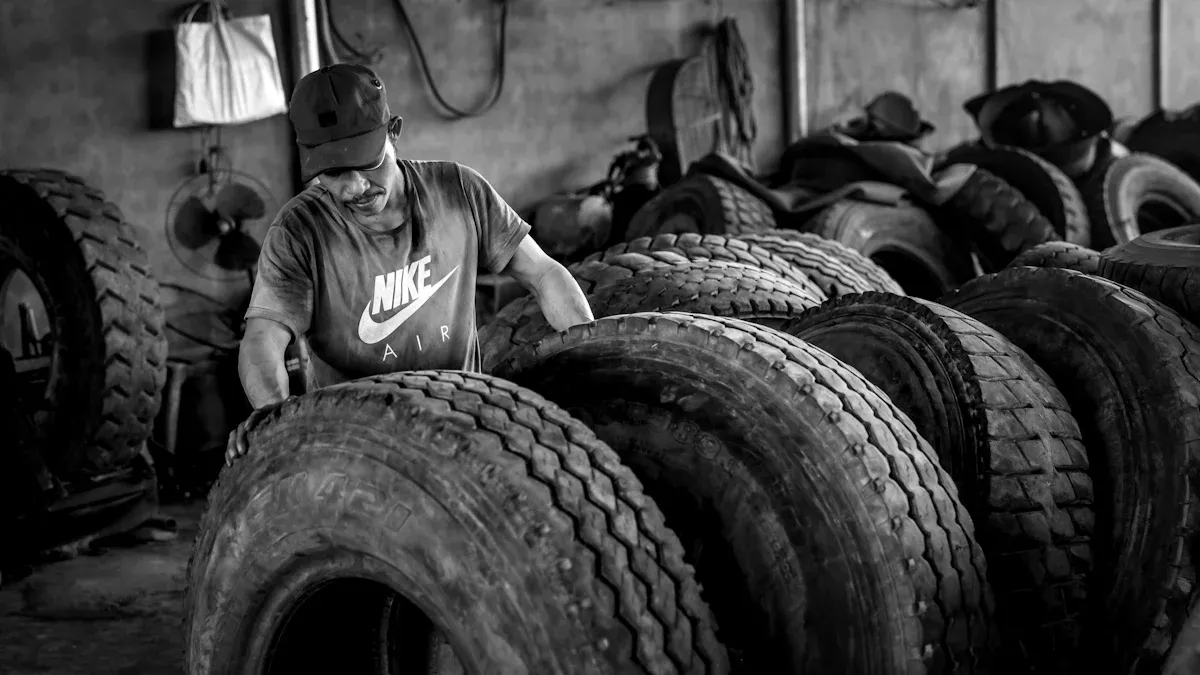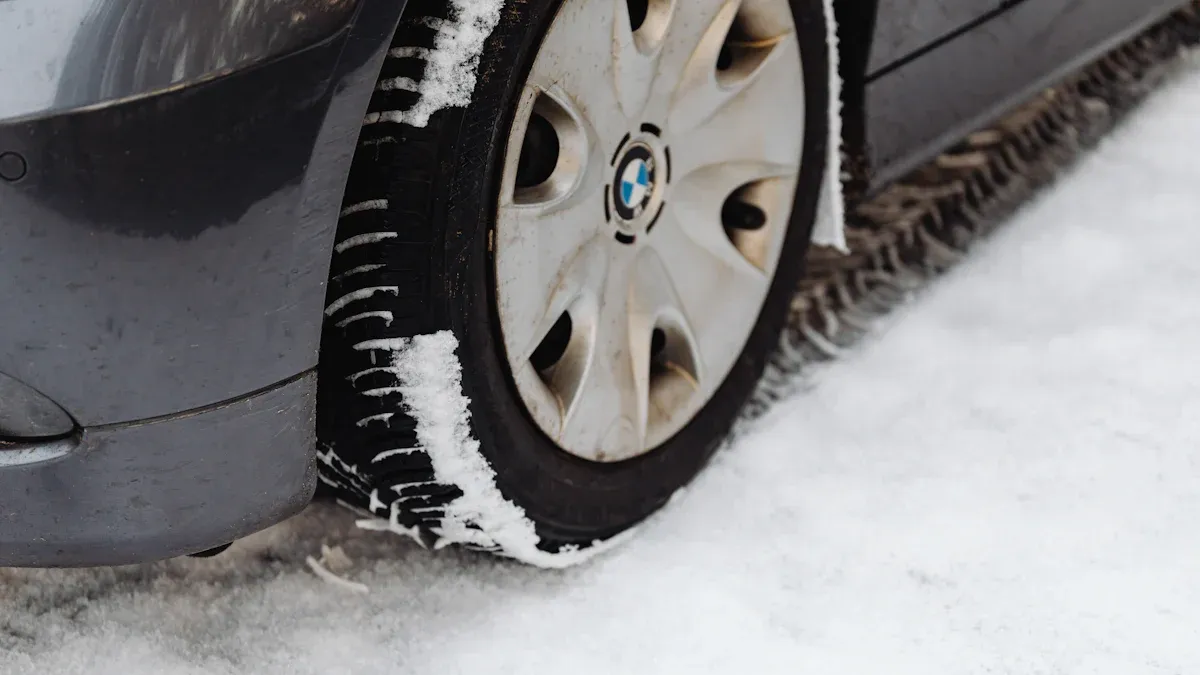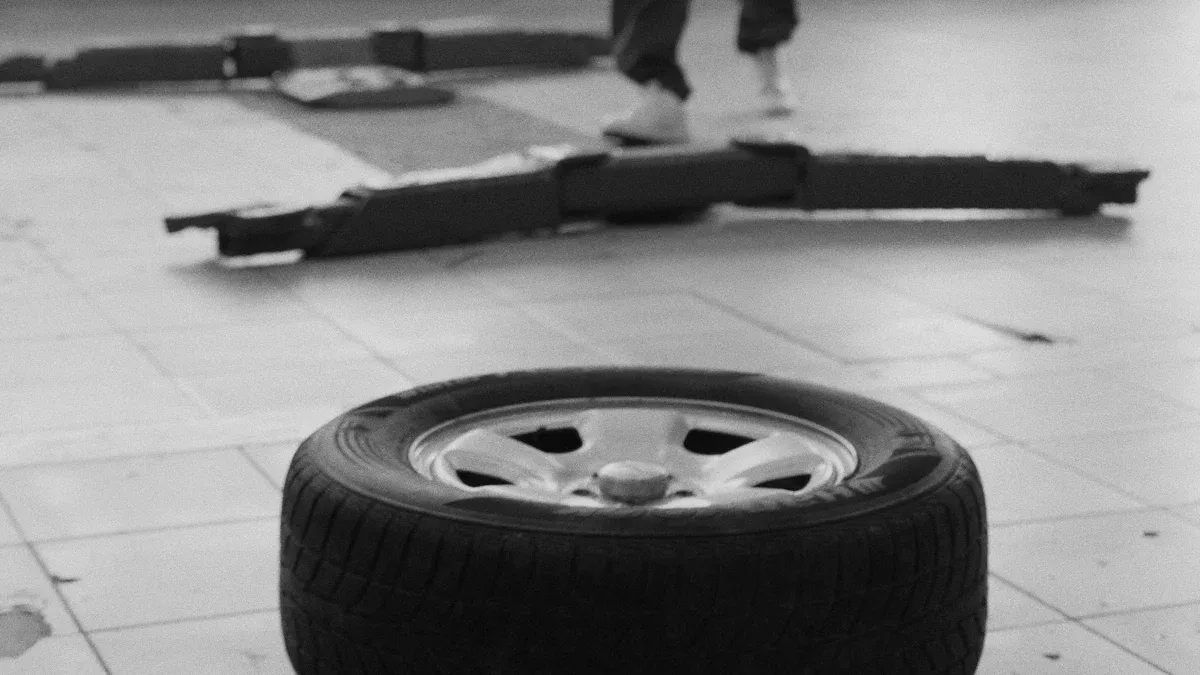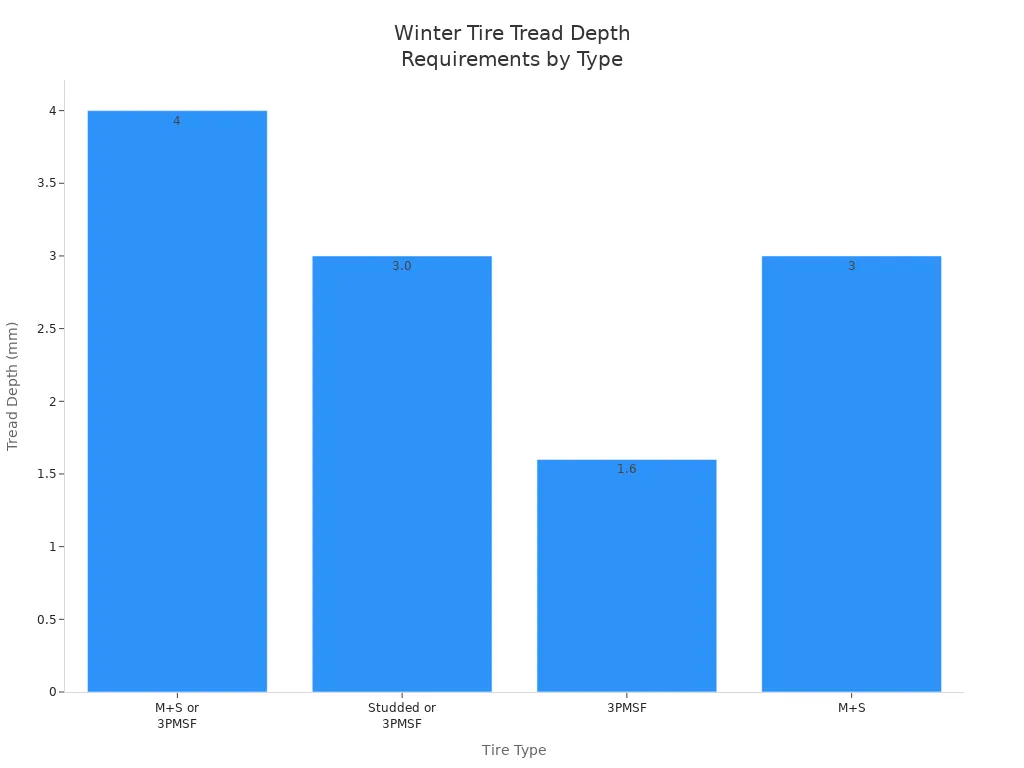
Winter tire safety is crucial for your overall well-being on the road. As winter approaches, the presence of ice and snow can make driving challenging. Tires that are properly maintained provide you with improved grip and control. It’s essential to frequently check your tire tread depth and condition. This simple task can significantly reduce the risk of accidents during inclement weather. Remember, your safety depends on the effectiveness of your winter tires.
Ключевые выводы
Проверьте глубину протектора ваших шин often. This helps your tires grip icy roads well.
Check tire pressure at least once a month. Do this more in cold weather for safety.
Look for wear signs like cracks or uneven tread. Rotate your tires to make them last longer.
Do monthly maintenance checks. This helps find problems early and keeps driving safe.
Tire Tread Depth

Что такое глубина протектора?
Tread depth refers to the vertical measurement from the top of the tire’s tread rubber to the bottom of the deepest grooves. This measurement is crucial for winter tire safety. Adequate tread depth helps maintain traction, especially on wet and icy roads. As tread depth decreases, tires lose grip. This loss leads to longer stopping distances and increases the risk of skidding on slippery surfaces. Therefore, monitoring your tire tread depth is essential for safe winter driving.
Как измерить глубину протектора
You can measure tread depth using several effective methods. Here’s a quick overview of the most accurate techniques:
Метод | Описание |
|---|---|
Тест Пенни | A simple method using a penny to check if tread depth is above 2/32″. |
A tool that measures tread depth by inserting a probe into the tread grooves. | |
Tread Wear Indicator Bars | Built-in indicators that show when tread is worn down to 2/32″, signaling the need for replacement. |
To perform the penny test, insert a penny into the tread with Lincoln’s head facing down. If you can see the top of Lincoln’s head, your tread depth is too low. For a more precise measurement, consider using a tread depth gauge. This tool provides an exact reading of your tire’s tread depth. Regularly checking your tire tread depth can help ensure your safety on winter roads.
Winter Tire Safety and Tread Depth

Минимальная глубина протектора
Knowing the минимальной глубины протектора is very important for winter tire safety. For the best performance, winter tires should have a tread depth of at least 5/32 to 6/32 inches. This depth helps your tires push snow and slush away from the contact patch. This keeps your grip on slippery roads.
In many places, laws set specific tread depth rules for winter tires. Here’s a quick look at these rules:
Регион | Тип шины | Tread Depth Requirement (mm) | Mandatory Period |
|---|---|---|---|
Various | M+S or 3PMSF | 4 | 01.12. – 01.03. |
Various | Studded or 3PMSF | 3.0 | 01.11. – 31.03. |
Various | 3PMSF | 1.6 | 01.11. – 31.03. |
Various | M+S | 3 | 01.11. – 01.04. |
These rules show how important it is to keep enough tread depth for winter tire safety. Not following these rules can lead to fines and, more importantly, unsafe driving.
Tread Depth and Traction
Tread depth is very important for traction, especially in snow. As the tread gets worn down, your tires lose their grip on the road. This loss of traction can cause dangerous situations, like skidding or sliding on ice.
When you drive on tires with low tread depth, you might face:
Longer stopping distances: Worn tires take more time to stop, raising the chance of accidents.
Reduced control: It may be harder to steer or control your vehicle on slippery roads.
Increased hydroplaning risk: Shallow tread depth can cause hydroplaning on wet roads. This happens when your tires lose contact with the surface.
To stay safe, проверки глубины протектора шин often and change your winter tires when they reach the minimum depth. Remember, keeping proper tread depth is not just a law; it is a key part of winter tire safety that can save your life.

Tire Pressure in Winter
Effects of Cold Weather
Cold weather can really change your tire pressure. When it gets colder, the air in your tires shrinks. This makes the tire pressure go down. For every 10°F drop in temperature, your tire pressure drops by about 1 PSI (pound per square inch). Low tire pressure can cause problems like less traction, faster tire wear, and worse fuel efficiency. So, you need to check your tire pressure often during winter to drive safely.
Checking Tire Pressure
To keep your tire pressure right, follow these steps:
Tire Cool Down: Always check your tire pressure when the tires are cool. This means checking them before you drive or at least three hours after driving.
Vehicle Manufacturer’s Recommended Tire Pressure: Look at the door placard on your vehicle. This placard shows the right PSI for your tires.
Проверяйте давление в шинах: Use a good tire pressure gauge to measure the pressure in each tire. Digital gauges usually give the most accurate readings.
Inflate to Recommended PSI: If the pressure is low, pump each tire to the right pressure. Check the pressure again after inflating to make sure it’s correct.
Совет: Try to check your tire pressure at least once a month during winter. This easy task can help you avoid dangerous driving conditions.
Keeping the right tire pressure is very important for safe winter driving. By following these steps, you can make sure your tires work well in cold weather. Remember, paying attention to your tires can help keep you safe on the road.
Lifespan of Winter Tires
Signs of Wear
You need to check your winter tires often for wear. Spotting these signs early helps you know when to get new tires. Here are some signs to look for:
Трещины или порезы: Check for cracks or cuts on the sidewalls. These can make the tire weak and cause blowouts.
Bald Spots: If you see bald spots, your tires might not grip well. This can be risky in winter.
Неравномерный износ: Look for uneven wear on the tread. This can mean alignment problems or wrong inflation.
Vibration: If you feel strong vibrations while driving, it could mean a tire issue.
If you see any of these signs, think about getting new tires. Worn tires can make driving on icy roads unsafe.
Tire Rotation Tips
Rotating your tires regularly is important for making your winter tires last longer. Tire rotation helps keep wear even on all tires. This is key for good traction and stability in winter. Here are some tips for tire rotation:
Частота: Rotate your tires every 5,000 to 7,500 miles or as your vehicle says.
Pattern: Use the right rotation pattern for your vehicle. Common patterns are front-to-back or crisscross.
Inspection: When you rotate, check each tire for wear. This is a good time to проверки глубины протектора and condition.
By reducing uneven wear, tire rotation helps your winter tires last longer. This saves you money and helps the environment. Remember, uneven tire wear can lead to less traction, longer stops, and more hydroplaning risk. Keeping your tires in good shape is very important for safe winter driving.
Совет: Make tire rotation a regular part of your vehicle care. This easy step can greatly improve your safety on the road.
Regular Maintenance Checks
Frequency of Inspections
You should check your winter tires at least once a month. Regular checks help you find problems early. Look for signs like cracks, cuts, or uneven tread. These issues can cause dangerous situations on icy roads. Checking your tires every month keeps them in good shape all winter long.
Additional Maintenance Tips
Besides regular checks, try these tips to make your winter tires last longer:
Визуальные осмотры: Look at your tires for tread life, cracks, and debris. This easy step can stop big problems.
Monitor Tire Pressure: Cold weather can lower tire pressure. Check your tire pressure often to avoid being underinflated.
Warm Up Your Equipment: Let your vehicle warm up before driving. This helps your tires work better in cold weather.
To avoid sidewall damage, do these things:
Inspect for Uneven Wear: Check for uneven wear patterns. This can show alignment problems or wrong inflation.
Поддерживайте правильное давление: Keeping your tires inflated helps stop uneven wear and makes them last longer.
Rotate Tires: Rotating your tires regularly helps them wear evenly and need replacing on time. This is key for good traction and stability.
Check Alignment: Regular alignment checks can stop uneven wear and possible tire damage.
By following these tips, you can improve your winter tire safety and have a smoother drive. Remember, taking care of your tires can help you avoid accidents and expensive repairs.
Taking care of your winter tires is very important for safe driving. Here are some main tips to keep in mind:
Проверьте глубину протектора often to make sure you have enough grip.
Monitor tire pressure regularly, especially when it’s cold.
Look for signs of wear and rotate your tires when needed.
Do monthly maintenance checks чтобы выявить проблемы на ранней стадии.
Checking your winter tires often can help you avoid accidents and stay safe on the road. Follow these steps to make sure your vehicle works well this winter! 🚗❄️
Часто задаваемые вопросы
How often should I check my winter tire pressure?
You should check your winter tire pressure at least once a month. Cold weather can lower tire pressure, affecting traction and safety. Regular checks help you maintain proper inflation.
What is the ideal tread depth for winter tires?
The ideal tread depth for winter tires is between 5/32 and 6/32 inches. This depth ensures optimal traction on snow and ice, helping you stay safe on the road.
Когда мне нужно заменить зимние шины?
Replace your winter tires when the tread depth reaches 5/32 inches or less. Also, look for signs of wear, such as cracks or uneven tread, which indicate it’s time for new tires.
Могу ли я использовать всесезонные шины зимой?
All-season tires can handle light winter conditions but may not provide the same traction as winter tires. For severe winter weather, winter tires are recommended for better grip and safety.
How can I extend the lifespan of my winter tires?
To extend the lifespan of your winter tires, rotate them regularly, maintain proper inflation, and check for signs of wear. Proper care helps ensure your tires perform well throughout the winter season.
Смотрите также
Важность контроля глубины протектора шин для безопасности
Использование измерителя глубины протектора для точных измерений






